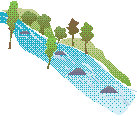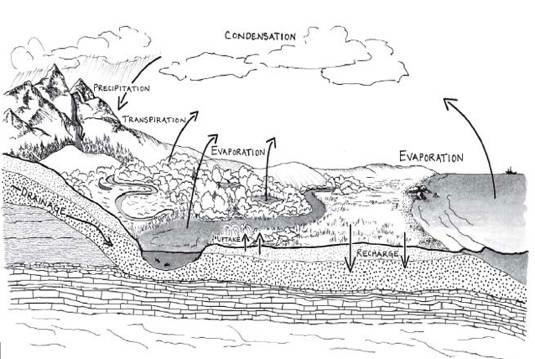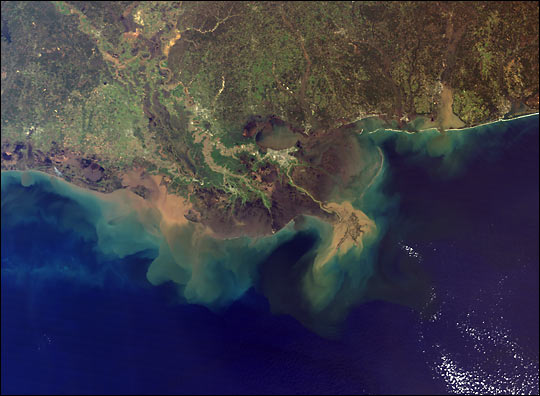
Key Characteristics of Rivers and Streams
Background reading - Global Lab
• Streams or rivers form when water that does not find an underground aquifer, drains off the land by either seeping through the soil or spilling over the surface into the river or stream bed.
• Water in streams and rivers is in constant motion. The speed of the water depends on the slope of the land, the size and shape of the bed, the amount of water, and the amount of material carried by the water.
• As river and stream water travels, it shapes its own channel by forcing itself into rock cracks and prying pieces loose, by rubbing sand, gravel, and rocks against banks, and by dissolving rock substances such as limestone into the flowing water.
• Streams and rivers have shaped the history of humankind by providing drinking water, food, irrigation, and transportation. |
Rivers and Streams Flow Downstream
The water in rivers and streams is in constant motion. It moves faster with a steep gradient; a high volume of water getting through a small stream or river bed, it will go fast, too. Though the average speed of moving water is about 5–6 kilometers (3–4 miles) an hour (a fast walk for humans), the speed can range up to 31 km (19 miles) an hour during floods. Water moves fastest in the middle of the channel and around the outside of a curve, where it carves under the banks. The slower waters on the inside of a curve cause rock and other carried materials to fall out.
Much of the land around us has been shaped by flowing water. Over time, rivers smooth out their beds. As rivers cut through softer rock faster than through harder rock, waterfalls and rapids are associated with young rivers. Over time, canyons may be lifted up while their rivers continue to cut down into bedrock. |
Rivers and Stream are Part of the Water Cycle.

(picture by Betsy Feldman)
Streams and rivers often begin high in mountains, where their source (or headwaters) is melting snow. Their mouths form deltas and alluvial fans as they approach lakes, seas, or oceans. Near the head, the water flow is shallow and carries a lot of material. Later, as the stream or river drops its load, it will begin to meander (wander), cutting banks and making sand bars. If the river floods, it cuts across the meanders, creating oxbows and oxbow lakes. People looking at the landscape on Mars have been struck by features similar to those made by moving water (and air) on our own planet.
The water cycle returns fresh water, but not necessarily to its source. |
Rivers and Streams Carry Particles
Water is a great carrier of materials, especially in the constantly moving water of rivers and streams. Stationary or slow water drops its contents, but faster water gathers new materials and can carry them quite a distance. Moving water erodes river and stream banks, by cutting away soil and rock. Fast-moving water can also pick up small clay particles that tend to stick to the bottom. Millions of tons of material wash down rivers and streams every year.
• Material can be carried on the bottom of the stream or river bed. Bottom rocks of all sizes slowly tumble along in the current. They carve through softer rock as the river flows, or form piles of rubble.
• Material can be carried in suspension. Silt and clay are carried along, making the waters cloudy.
• Material can be carried in solution. Material is dissolved, broken down into ions, and carried along with the water. |
Rivers Fan Out in Deltas
Deltas are fan-shaped deposits that form at the mouth of a river. As the moving water enters a still or slow-moving body (such as the ocean), it drops its load of particles and materials. As these materials fill the river channel, the water moves around and forms new paths of flow. These secondary channels also slowly fill up with deposited materials, and the water fans out again, forming a delta.

Mississippi Delta with sediment from upstream being discharged. (NASA)
http://veimages.gsfc.nasa.gov/1650/modis_mississippi_sed.jpg
Deltas are continually changing their shape and depth as more materials are carried downstream and deposited at the river mouth.
Deltas vary. Great rivers with great deltas include the Tigris and Euphrates, the Nile, the Yangtse, the Ganges, the Mississippi, and the Indus rivers. Silt from rivers continues to settle. The Columbia River in the northwestern United States, on the other hand, discharges into the ocean, but does not form a delta because powerful waves and tides quickly distribute the sediment. |
| Return to Upstream Downstream Index |


